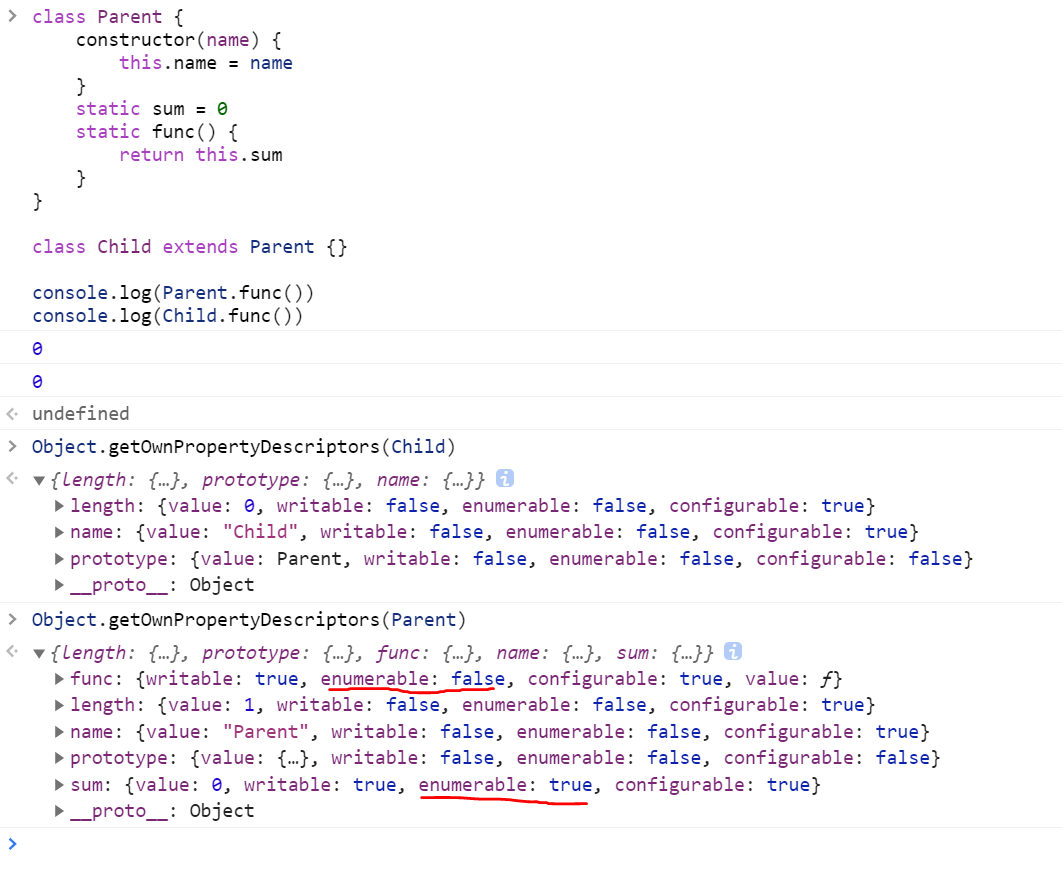1、原型链继承
构造函数、原型和实例之间的关系:每个构造函数都有一个原型对象(
prototype),原型对象都包含一个指向构造函数的指针(constructor ),而实例都包含一个原型对象的指针([[prototype]]属性,可以通过_proto_获取)。 继承的本质就是复制,即重写原型对象,代之以一个新类型的实例。
function SuperType() {
this.property = true;
}
SuperType.prototype.getSuperValue = function() {
return this.property;
}
function SubType() {
this.subproperty = false;
}
// 这里是关键,创建SuperType的实例,并将该实例赋值给SubType.prototype
SubType.prototype = new SuperType();
SubType.prototype.getSubValue = function() {
return this.subproperty;
}
var instance = new SubType();
console.log(instance.getSuperValue()); // true原型链方案存在的缺点:多个实例对引用类型的操作会被篡改。
function SuperType(){
this.colors = ["red", "blue", "green"];
}
function SubType(){}
SubType.prototype = new SuperType();
var instance1 = new SubType();
instance1.colors.push("black");
alert(instance1.colors); //"red,blue,green,black"
var instance2 = new SubType();
alert(instance2.colors); //"red,blue,green,black"2、借用构造函数继承
使用父类的构造函数来增强子类实例,等同于复制父类的实例给子类(不使用原型)
function SuperType(){
this.color=["red","green","blue"];
}
function SubType(){
//继承自SuperType
SuperType.call(this);
}
var instance1 = new SubType();
instance1.color.push("black");
alert(instance1.color);//"red,green,blue,black"
var instance2 = new SubType();
alert(instance2.color);//"red,green,blue"核心代码是SuperType.call(this),创建子类实例时调用SuperType构造函数,于是SubType的每个实例都会将SuperType中的属性复制一份。
缺点:
- 只能继承父类的实例属性和方法,不能继承原型属性/方法
- 无法实现复用,每个子类都有父类实例函数的副本,影响性能
3、组合继承
组合上述两种方法就是组合继承。用原型链实现对原型属性和方法的继承,用借用构造函数技术来实现实例属性的继承。
function SuperType(name){
this.name = name;
this.colors = ["red", "blue", "green"];
}
SuperType.prototype.sayName = function(){
alert(this.name);
};
function SubType(name, age){
// 继承属性
// 第二次调用SuperType()
SuperType.call(this, name);
this.age = age;
}
// 继承方法
// 构建原型链
// 第一次调用SuperType()
SubType.prototype = new SuperType();
// 重写SubType.prototype的constructor属性,指向自己的构造函数SubType
SubType.prototype.constructor = SubType;
SubType.prototype.sayAge = function(){
alert(this.age);
};
var instance1 = new SubType("Nicholas", 29);
instance1.colors.push("black");
alert(instance1.colors); //"red,blue,green,black"
instance1.sayName(); //"Nicholas";
instance1.sayAge(); //29
var instance2 = new SubType("Greg", 27);
alert(instance2.colors); //"red,blue,green"
instance2.sayName(); //"Greg";
instance2.sayAge(); //27缺点:
- 第一次调用SuperType():给SubType.prototype写入两个属性name,color。
- 第二次调用SuperType():给instance1写入两个属性name,color。
实例对象instance1上的两个属性就屏蔽了其原型对象SubType.prototype的两个同名属性。所以,组合模式的缺点就是在使用子类创建实例对象时,其原型中会存在两份相同的属性/方法。
4、原型式继承
利用一个空对象作为中介,将某个对象直接赋值给空对象构造函数的原型。
function object (obj) {
function F () {
}
F.prototype = obj
return new F ()
}object()对传入其中的对象执行了一次浅复制,将构造函数F的原型直接指向传入的对象。
var person = {
name: "Nicholas",
friends: ["Shelby", "Court", "Van"]
};
var anotherPerson = object(person);
anotherPerson.name = "Greg";
anotherPerson.friends.push("Rob");
var yetAnotherPerson = object(person);
yetAnotherPerson.name = "Linda";
yetAnotherPerson.friends.push("Barbie");
alert(person.friends); //"Shelby,Court,Van,Rob,Barbie"缺点:
- 原型链继承多个实例的引用类型属性指向相同,存在篡改的可能。
- 无法传递参数
另外,ES5中存在Object.create()的方法,能够代替上面的object方法。
5、寄生式继承
核心:在原型式继承的基础上,增强对象,返回构造函数
function createAnother(original){
var clone = new Object(original); // 通过调用 object() 函数创建一个新对象
clone.sayHi = function(){ // 以某种方式来增强对象
alert("hi");
};
return clone; // 返回这个对象
}函数的主要作用是为构造函数新增属性和方法,以增强函数
var person = {
name: "Nicholas",
friends: ["Shelby", "Court", "Van"]
};
var anotherPerson = createAnother(person);
anotherPerson.sayHi(); //"hi"缺点(同原型式继承)::
- 原型链继承多个实例的引用类型属性指向相同,存在篡改的可能。
- 无法传递参数
6、寄生组合式继承
结合借用构造函数传递参数和寄生模式实现继承
// 本质 本质在于 subType.prototype.__proto === superType.prototype;
function inheritPrototype(subType, superType){
var prototype = Object.create(superType.prototype); // 创建对象,创建父类原型的一个副本
prototype.constructor = subType; // 增强对象,弥补因重写原型而失去的默认的constructor 属性
subType.prototype = prototype; // 指定对象,将新创建的对象赋值给子类的原型
}
// 父类初始化实例属性和原型属性
function SuperType(name){
this.name = name;
this.colors = ["red", "blue", "green"];
}
SuperType.prototype.sayName = function(){
alert(this.name);
};
// 借用构造函数传递增强子类实例属性(支持传参和避免篡改)
function SubType(name, age){
SuperType.call(this, name);
this.age = age;
}
// 将父类原型指向子类
inheritPrototype(SubType, SuperType);
// 其实就是这样
SubType.prototype = Object.create(SuperType.prototype)
SubType.prototype.constructor = SubType
// 新增子类原型属性
SubType.prototype.sayAge = function(){
alert(this.age);
}
var instance1 = new SubType("xyc", 23);
var instance2 = new SubType("lxy", 23);
instance1.colors.push("2"); // ["red", "blue", "green", "2"]
instance1.colors.push("3"); // ["red", "blue", "green", "3"]这个例子的高效率体现在它只调用了一次SuperType 构造函数,并且因此避免了在SubType.prototype 上创建不必要的、多余的属性。于此同时,原型链还能保持不变;因此,还能够正常使用instanceof 和isPrototypeOf() 这是最成熟的方法,也是现在库实现的方法
var person = {
name: "Nicholas",
friends: ["Shelby", "Court", "Van"]
};
var anotherPerson = createAnother(person);
anotherPerson.sayHi(); //"hi"缺点:
- 子类想要在原型上添加方法,必须在继承之后添加,否则将覆盖掉原有原型上的方法。这样的话 若是已经存在的两个类,就不好办了。
7、混入方式继承多个对象
function MyClass() {
SuperClass.call(this);
OtherSuperClass.call(this);
}
// 继承一个类
MyClass.prototype = Object.create(SuperClass.prototype);
// 混合其它
Object.assign(MyClass.prototype, OtherSuperClass.prototype);
// 重新指定constructor
MyClass.prototype.constructor = MyClass;
MyClass.prototype.myMethod = function() {
// do something
};Object.assign会把 OtherSuperClass原型上的函数拷贝到 MyClass原型上,使 MyClass 的所有实例都可用 OtherSuperClass 的方法。
8、ES6类继承extends
extends关键字主要用于类声明或者类表达式中,以创建一个类,该类是另一个类的子类。其中constructor表示构造函数,一个类中只能有一个构造函数,有多个会报出SyntaxError错误,如果没有显式指定构造方法,则会添加默认的 constructor方法,使用例子如下。
class Rectangle {
static value = 'static'
// constructor
constructor(height, width) {
this.height = height;
this.width = width;
}
// Getter
get area() {
return this.calcArea()
}
// Method
calcArea() {
return this.height * this.width;
}
}
const rectangle = new Rectangle(10, 20);
console.log(rectangle.area);
// 输出 200
// 继承
class Square extends Rectangle {
constructor(length) {
super(length, length);
// 如果子类中存在构造函数,则需要在使用“this”之前首先调用 super()。
this.name = 'Square';
}
get area() {
return this.height * this.width;
}
}
const square = new Square(10);
console.log(square.area);
// 输出 100
Square.__proto__ === Rectangle // true 继承属性
Square.prototype.__proto__ === Rectangle.prototype // true 继承方法
console.log(Object.getPrototypeOf(square) === Square.prototype) // true
console.log(Object.getPrototypeOf(Square.prototype) === Rectangle.prototype) //true
console.log(Square.value) // 'static'
console.log(square.value) // undefinedextends继承的核心代码如下,其实现和上述的寄生组合式继承方式一样
function _inherits(subType, superType) {
// 创建对象,创建父类原型的一个副本
// 增强对象,弥补因重写原型而失去的默认的constructor 属性
// 指定对象,将新创建的对象赋值给子类的原型
// 完成了下面2件事情
// subType.__proto__ === superType;
// subType.prototype.__proto__ === superType.prototype;
subType.prototype = Object.create(superType && superType.prototype, {
constructor: {
value: subType,
enumerable: false,
writable: true,
configurable: true
}
});
if (superType) {
Object.setPrototypeOf
? Object.setPrototypeOf(subType, superType)
: subType.__proto__ = superType;
}
}静态方法和静态属性
class Parent {
constructor(name) {
this.name = name
}
static sum = 0
static func() {
return this.sum
}
}
class Child extends Parent {}
console.log(Parent.func()) // 0
console.log(Child.func()) // 0
super
- super作为函数调用时,代表父类的构造函数。ES6 要求,子类的构造函数必须执行一次super函数。只能在
constructor中第一行调用. - super作为对象时,在普通方法中,指向父类的原型对象;在静态方法中,指向父类。ES6 规定,在子类普通方法中通过super调用父类的方法时,方法内部的this指向当前的子类实例。由于this指向子类实例,所以如果通过super对某个属性赋值,这时super就是this,赋值的属性会变成子类实例的属性。
class A {
constructor() {
this.x = 1;
}
}
class B extends A {
constructor() {
super();
this.x = 2;
super.x = 3;
console.log(super.x); // undefined
console.log(this.x); // 3
}
}
let b = new B();extends
Class 作为构造函数的语法糖,同时有prototype属性和__proto__属性,因此同时存在两条继承链。
- 子类的
__proto__属性,表示构造函数的继承,总是指向父类。 - 子类
prototype属性的__proto__属性,表示方法的继承,总是指向父类的prototype属性。
class A {
}
class B extends A {
}
B.__proto__ === A // true
B.prototype.__proto__ === A.prototype // true总结
1、 函数声明和类声明的区别 函数声明会提升,类声明不会。首先需要声明你的类,然后访问它,否则像下面的代码会抛出一个ReferenceError。
let p = new Rectangle();
// ReferenceError
class Rectangle {}2、 ES5继承和ES6继承的区别
- ES5的继承实质上是先创建子类的实例对象,然后再将父类的构造方法添加到this上(
Parent.call(this)). - ES6的继承有所不同,实质上是先创建父类的实例对象this,然后再用子类的构造函数修改this。因为子类没有自己的this对象,所以必须先调用父类的super()方法,否则新建实例报错。
- ES6类必须使用new调用,否则会报错。这是它跟普通构造函数的一个主要区别,后者不用new也可以执行。
- ES6类的所有实例共享一个原型对象。
- ES6类的内部,默认就是严格模式,所以不需要使用
use strict指定运行模式。
es6继承步骤解析
class Point {
constructor(x, y){
this.x = x
this.y = y
}
toString(){
return '(' + this.x + ', ' + this.y + ')'
}
}
class ColorPoint extends Point {
constructor(x, y, color){
super(x, y) // 调用父类的constructor(x, y)
this.color = color
}
toString(){
return this.color + ' ' + super.toString()
}
}babel 转译后
var ColorPoint =
/*#__PURE__*/
function(_Point){
_inherits(ColorPoint, _Point)
function ColorPoint(x, y, color){
var _this
_classCallCheck(this, ColorPoint)
_this = _possibleConstructorReturn(this, _getPrototypeOf(ColorPoint).call(this, x, y)) // 调用父类的constructor(x, y)
_this.color = color
return _this
}
_createClass(ColorPoint, [{
key: 'toString',
value: function toString(){
return this.color + ' ' + _get(_getPrototypeOf(ColorPoint.prototype), 'toString', this).call(this)
}
}])
return ColorPoint
}(Point)如上是经过babel转译后的代码,有几个关键点:
一、 _inherits()
function _inherits(subClass, superClass) {
if (typeof superClass !== "function" && superClass !== null) {
throw new TypeError("Super expression must either be null or a function");
}
subClass.prototype = Object.create(superClass && superClass.prototype, {
constructor: {
value: subClass,
writable: true,
configurable: true
}
});
if (superClass) _setPrototypeOf(subClass, superClass);
}
function _setPrototypeOf(obj, proto) {
obj.__proto__ = proto
return obj
}首先完成extends对象的校验,必须是function 或者null,否则报错。其次完成以下事情:
ColorPoint.__proto__ = Point
ColorPoint.prototype.__proto__ = Point.prototype二、 ColorPoint 构造函数中 _classCallCheck(), _possibleConstructorReturn()
function _classCallCheck(instance, Constructor) {
if (!_instanceof(instance, Constructor)) {
throw new TypeError("Cannot call a class as a function");
}
}主要是用来检测构造函数不能直接调用,必须是通过new的方式来调用。
function _possibleConstructorReturn(self, call){
if (call && (_typeof(call) === 'object' || typeof call === 'function')) {
return call
}
return _assertThisInitialized(self)
}调用父类的构造函数,初始化一些实例属性,并将this返回。使用该返回的this赋值给子类的this对象,子类通过这一步返回的this对象,再该基础之上在添加一些实例属性。
这就是最大的不同之处。如果不经历这一步,子类没有this对象,一旦操作一个不存在的this对象就会报错。
三、 _createClass()
最后一步完成原型属性与静态属性的挂载,如果是原型属性,挂在在constructor上的prototype上,如果是静态属性或者静态方法,则挂在constructor 上。
function _createClass(Constructor, protoProps, staticProps){
if (protoProps) _defineProperties(Constructor.prototype, protoProps)
if (staticProps) _defineProperties(Constructor, staticProps)
return Constructor
}